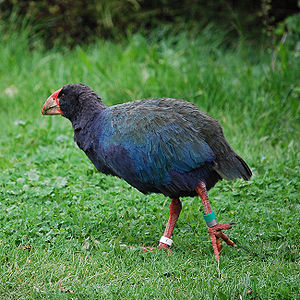- Takahē
-
"Notornis" redirects here. For the journal, see Notornis (journal).
South Island Takahē 
On Tiritiri Matangi Island Conservation status Scientific classification Kingdom: Animalia Phylum: Chordata Class: Aves Order: Gruiformes Family: Rallidae Genus: Porphyrio Species: P. hochstetteri Binomial name Porphyrio hochstetteri
(A. B. Meyer, 1883)Synonyms Notornis mantelli Mantell, 1847
Porphyrio mantelli hochstetteri ,The Takahē or South Island Takahē, Porphyrio hochstetteri is a flightless bird indigenous to New Zealand and belonging to the rail family. It was thought to be extinct after the last four known specimens were taken in 1898. However, after a carefully planned search effort the bird was rediscovered by Geoffrey Orbell near Lake Te Anau in the Murchison Mountains, South Island, on November 20, 1948. The specific scientific name commemorates the Austrian geologist Ferdinand von Hochstetter.
A related species, the North Island Takahē (P. mantelli) or mōho is extinct and only known from skeletal remains. Both forms were long assumed to be subspecies of mantelli, and were usually placed in the genus Notornis. However, it has been determined that the differences between Porphyrio and Notornis were insufficient for separating the latter, whereas the differences between the North and South Island forms justified the splitting into two species, as each evolved independently towards flightlessness.
Contents
Description
The Takahē is the largest living member of the Rallidae family. Its overall length averages 63 cm (24.8 in) and its average weight is about 2.75 kg (6 lbs), ranging from 1.8-4.2 kg (4-9.2 lbs). The standing height is around 50 cm (20 in).[1] It is a stocky bird, with reduced wings, strong legs and a massive bill.
The adult Takahē is mainly purple-blue in color, with a greenish back and inner wings. It has a red frontal shield and red-based pink bill. The legs are pink. Sexes are similar, the females being slightly smaller, but young birds have mainly pale brown plumage. This is a noisy species with a loud clowp call.
Distribution and habitat
The species is still present in the location where it was rediscovered in the Murchison Mountains. Small numbers have also been successfully translocated to four predator-free offshore islands, Tiritiri Matangi, Kapiti, Maud and Mana, where they can be viewed by the public. Additionally, captive Takahē can be viewed at Te Anau and Mt Bruce wildlife centres. In June 2006 a pair of Takahē were relocated to the Maungatautari Restoration Project. In January 2011 a small number of Takahe were released in Zealandia, Wellington.
In total there were 225 remaining birds, but in July 2008, a Department of Conservation worker shot one on Mana Island, after mistaking it for a pukeko during a cull.
Conservation
The near-extinction of the Takahē is due to a number of factors: over-hunting, loss of habitat and introduced predators have all played a part. Since the species is long-lived, reproduces slowly, takes several years to reach maturity, and had a large range that has drastically contracted in comparatively few generations, inbreeding depression is a significant problem. The recovery efforts are hampered especially by low fertility of the remaining birds; genetic analyses have been employed to select captive breeding stock in an effort to preserve the maximum genetic diversity.
Behaviour
The Takahē is found in alpine grasslands habitats. It eats grass, shoots and insects. The Takahē can often be seen to pluck a snow grass stalk, taking it into one claw and eating only the soft lower parts which is a favourite food. The rest is discarded.
Breeding
This species builds a bulky nest under bushes and scrub and lays two buff eggs. It is territorial. The chick survival rate is 73-97%.
Gallery
References
- ^ Taylor, Barry, Rails: A Guide to the Rails, Crakes, Gallinules and Coots of the World. Yale University Press (1998), ISBN 978-0300077582.
- Rails by Taylor and van Perlo, ISBN 90-74345-20-4
- Finding an 'Extinct' New Zealand Bird by R. V. Francis Smith, National Geographic Magazine, March 1952, p. 393.
- Royal Forest & Bird Society (NZ) page on Takahē
- NZ Department of Conservation page on Takahē
- TerraNature page on Takahē
- BirdLife International 2009. Species factsheet: Porphyrio hochstetteri. Downloaded on 01 December 2009.
- BirdLife International 2008. Porphyrio hochstetteri. In: IUCN 2009. IUCN Red List of Threatened Species. Version 2009.2. Downloaded on 01 December 2009.
External links
- Takahē videos on the Internet Bird Collection
Categories:- IUCN Red List endangered species
- Porphyrio
- Birds of New Zealand
- Flightless birds
- Māori words and phrases
Wikimedia Foundation. 2010.







